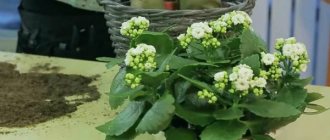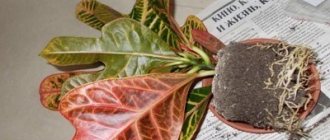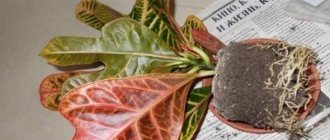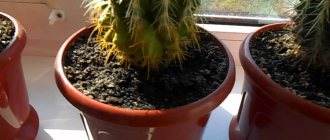When is a transplant needed?
The plant really needs replanting. As the roots grow, they gradually fill the container where it lives. There are several cases when a transplant is required:
- roots appear from the drainage holes and extend beyond the pot;
- the plant is sick, depressed, and loses its decorative properties. The leaves turn yellow, fungal infections are detected;
- the appearance of pests in the soil, including the possibility of egg laying;
- The old pot has become unusable.
Begonia in bloom
In some cases, the plant has not yet reached large size, but the pot was found to be completely filled with roots. This means that the time has come to change the container. Begonias that have not yet mastered the entire capacity and are healthy are not transplanted.
There is another case when replacing the pot is necessary. The flower is provided with another pot and fresh soil. The begonia plant needs replanting after purchase. It is not recommended to rush through the procedure, but in a store-bought container the plant will sooner or later wither.
How often to replant begonia?
How to transplant a ficus at home to a new place
The transfer of the plant from the old container is planned in early spring. This choice of time of year is the most correct, because growth processes are just beginning to intensify. At this time, the indoor flower will endure the procedure and recover with minimal losses.
Important ! With excessive growth of the root system, the risk of injury increases. This situation cannot be allowed to happen.
Experienced gardeners believe that changing the container and soil should be made an annual event. This is due to the fact that the soil becomes depleted over time. The plant is given the opportunity to restore its composition, replenishing it with the necessary nutrients. It is better not to forget about the regularity of the procedure in order to avoid death.
It's time to replant the begonia
There is another important question: is it possible to replant begonia that is currently blooming? This should be done only after the flowering process is complete. Then the procedure will be safe, otherwise the flowers will begin to fall off. There is a possibility that the plant will lose its decorative qualities, taking on a sickly appearance.
How to choose a pot and soil?
How to transplant an orchid to a new place
A competent choice of container and soil will be the key to health for begonias. This is the most important factor in the question of how to replant begonia. You need to make sure you have everything you need before the transplant event. The list of components is as follows:
- a suitable pot should not be overly large. Young begonias are transplanted into containers that are 3 or 4 cm larger in diameter than the previous ones;
- The material of the container is important. They prefer ceramics, although plastic is also suitable for creating the necessary conditions;
- When deciding how to plant begonia, for each part they take containers 2 or 3 cm smaller than the previous one. When separating the rosettes, the original plant is left in its original container. Technological pots have a size of 6 by 6 cm;
- soil mixture of suitable quality. This is a mixture of peat, turf, humus and ordinary soil in equal proportions;
- drainage as the basis for comfort. They take expanded clay, crushed stone, pieces of foam plastic and other materials.
Having prepared the listed components of the process, they begin to transfer the plant to a new place of residence.
Begonia in a new pot
Important ! The shape of the next pot should not create additional difficulties. For example, if the edges are curved inward, it is easy for pests to hide there.
Blooming begonia is not replanted
Soil disinfection
There is one nuance in the question of how to properly transplant begonia at home step by step. It is important to disinfect the soil, which will ensure the absence of pests that can attack the plant from soil infested with larvae. It is convenient to use an ordinary microwave oven for the procedure.
Pest infestation
The appearance of pests, as a rule, is provoked by improper care of indoor plants. Pests that may appear if tuberous begonias are not properly cared for:
- Powdery mildew is the most dangerous enemy for tuberous begonias. Its appearance is provoked by abundant watering of the plant. In order to get rid of powdery mildew, begonia must be treated with a fungicide. You can also use a regular solution made from garlic. In the future, to prevent such a pest from attacking your plants, it is recommended to moderately water the flower, regularly loosen the soil in the pot and ventilate the room in which the begonia is kept.
- Another pest of tuberous begonias is aphids. The fight against this enemy must be done manually. To do this, each affected leaf of the plant must be wiped with alcohol. You can also use specialized solutions that are sold in the store. 1 teaspoon of this product is dissolved in one liter of water. It is recommended to carry out treatment with the resulting solution.
- Spider mites, as a rule, attack the plant when the humidity in the room is very low. To combat this pest, the leaves must be treated with chamomile or a solution made from soap. You can also use specialized drugs, such as Intavir, Karbofos.
Preparing for transplant
When to dig up crocuses - transplant to a new place
The ceramic (or other) pot in the house is thoroughly washed. It is recommended to soak the clay version in water for a day and then scald it with boiling water. Plastic needs to be cleaned under running water and detergent. And also at the preparation stage, soil and drainage must be available.
Begonia in boxes
From seeds
How to propagate begonia with seeds? This can be done easily and quickly. Sowing is carried out at the end of February or in the first days of March. To do this, small seeds are distributed over the substrate. Then the container must be moved to a well-lit, warm place, covered in advance with film or glass.
Water the crops through a tray or with a sprayer. When the first seedlings appear, you need to remove the cover. Picking is performed after the formation of 3-4 leaf plates. After 8 weeks, the plants are transplanted into separate pots. Sometimes begonias bloom in the first year, but for this to happen, additional lighting is required.
Transplant methods
Two methods are possible: complete and partial transplantation. The first case refers to the purchase of a new plant or when diseases or pests are detected. Actions should be carried out as follows:
- Expanded clay is poured onto the bottom of the prepared pot;
- by pouring charcoal in the next layer, it will be possible to prevent rotting of the roots;
- drainage is covered with 2 cm of soil;
- Begonia can be easily removed from the previous container if you water it, turn it over or tilt it, and tap it a little;
- shake off the old soil. It won't hurt to wash the roots in a weak solution of potassium permanganate. Damaged and dead parts are removed;
- The plant is placed in a new container, holding the stem, and covered with fresh soil. The root collar is not buried.
All that remains is to lightly compact the soil. Although when watering, shrinkage will occur by itself, after which you just need to add more soil. The transfer method is applied to a healthy plant into a larger container. This is a gentle mode. Having moved the begonia along with the earthen lump into another pot, add fresh soil to the free space. This method only partially renews the soil.
Begonia transplant
Tuber division
Propagation of deciduous varieties is carried out by rhizomes. This procedure is carried out in the spring. To do this, pull the flower out of the soil and use a sharp knife to separate the rhizome into parts. Each division must have roots and at least 1 shoot or bud. The cut areas are sprinkled with crushed charcoal. Then the divisions must be planted in separate pots.
The tuber of an adult flower is also divided into parts. Then you need to wait until the cut areas dry out a little. They are dusted with crushed charcoal. Then the divisions must be planted in individual pots.
Care after replanting a plant
When properly caring for begonia, you need to take into account its light-loving nature. Active growth will be observed under intense but diffuse lighting. Immediately after transplantation, the pot is placed on a western or eastern window. Other rules are set out in the following list:
- exclusion of drafts;
- the temperature cannot be too low: from + 15 in winter and + 18-20 degrees in summer. Its stability and absence of changes are important;
- if diseases are detected, treatment is started immediately, otherwise the plant may be lost;
- in winter additional lighting will be required;
- Watering is done correctly, to which the flower crop responds well. Use only soft water, and remove excess water from the pan in a timely manner;
- Feeding applied on time (2 times a week) will help strengthen the immune system against diseases. The store has a range of fertilizers for begonias or indoor flowers. The dose is reduced by half.
The watering scheme requires special attention. Its frequency in summer should be at least 2 times a week, and in hot weather - every day. With the onset of autumn, by October the soil is moistened as its top layer dries. In winter, the frequency does not exceed twice a week. From March the amount of moisture increases. It is better not to spray the plant; unhealthy spots may appear. Maintain humidity by placing the pot on wet peat or pebbles.
Watering
Proper watering is necessary. This plant loves moisture, but it should not be moistened frequently. The main thing is that the air humidity is high, otherwise the tips of the leaf plates dry out. But in the summer, begonia should be watered abundantly, but not allow liquid to stagnate in the root system.
Watering should be done with water at room temperature that has been standing for at least 24 hours. This should be done after the top layer of soil has dried by 1.5 cm. In winter, watering should be done less frequently and moderately. And tuberous species do not need to be watered at this time.
Replanting after purchase
The rules for replacing the container with which the plant was purchased are similar to those outlined above. Planting can take place immediately. But it is not recommended to rush too much. The best solution is to wait for two weeks or a month. And if flowering is observed, the procedure is prohibited until it ends. The container size is usually left the same.
Typical mistakes during transplantation
An unsuccessful event can lead to the death of the plant. The following errors are indicated:
- The size of the new container is incorrectly selected. If the size is too large, the soil may turn sour and the roots will deteriorate;
- the soil is heavy, its permeability is insufficient, there is a lot of peat. All this provokes stagnation of water. Too much acidity (over 6.0) is also harmful;
- the root collar was buried, although it should have been left in its original position. Then the plant will rot.
Attention ! Good drainage is very important.
A home gardener will not need much effort and time to transplant begonias. The most important thing is to take care of the roots. Otherwise, it will be quite difficult for the plant to take root in a new place. Creating comfortable conditions is necessary, because only then will flowering occur.
Hot chocolate capsules Nescafe Dolce Gusto Chococino, 8 servings
334 ₽ More details
Nesquik Opti-Start instant cocoa drink, 250 g (package)
125 ₽ More details
Happy birthday balloons











